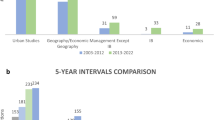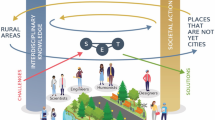Abstract
This paper explores the function of cities in the knowledge economy. The knowledge economy asks for “creative cities,” i.e. competitive urban areas that combine concentration, diversity, instability and a positive reputation. For a review of the concept of creative cities from a historical and theoretical perspective, we draw the conclusion that knowledge, creativity and innovation cannot be planned from scratch by local governments. However, creative cities par excellence such as Austin, the Øresund and Barcelona demonstrate that local policymakers in fact can play a part in preparing cities for the requirements of the knowledge economy. We conclude that local governments can increase the chance that urban creativity emerges by providing the appropriate underlying framework conditions.
Similar content being viewed by others
References
Acs, Z. J. (2002). Innovation and the Growth of Cities. Cheltenham: Edward Elgar.
Ajuntament de Barcelona (2000). The City of Barcelona. Barcelona: Ajuntament de Barcelona.
Andersson, Å. E. (1985). “Creativity and Regional Development.” Papers of the Regional Association, 56(1), 5–20.
Ashworth, G. J. and H. Voogd (1990). Selling the City. London: Belhaven.
Berg, L. van den, and E. Braun (1999). Urban Competitiveness, Marketing and the Need for Organizing Capacity. Urban Studies, 36 (5/6), 987–99.
Bishop, —. (2000). “As City Booms, Poor Get Poorer.” Austin American-Statesman, 2 January.
Buttimer, A. (1983). Creativity and Context. Lund: University of Lund.
Cairncross, F. (1997). The Death of Distance: How the Communications Revolution will Change our Lives. London: Texere.
Castells, M. and P. Hall (1994). Technopoles of the World: The Making of Twenty-First Industrial Complexes. London: Routledge.
Clark, G. L., M. P. Feldman and M. S. Gertler (Eds.) (2000). The Oxford Handbook of Economic Geography. Oxford: Oxford University Press.
Colledge, R. G. and R. J. Stimpson (1987). Analytical Behavior Geography. Beckenham: Croom Helm.
Cooke, Ph. (2002). Knowledge Economies: Clusters, Learning and Cooperative Advantage. London: Routledge.
Delamaide, D. (1994). The New Superregions of Europe. New York: Dutton.
Desrochers, P. (1998). A Geographical Perspective on Austrian Economics. The Quarterly Journal of Austrian Economics, 1(2), 63–83.
Dicken, P. (1998). Global Shift: Transforming the World Economy, 3rd edition. London: Chapman.
Drucker, P. (1999). Management Challenges for the 21st Century. New York: Harper Business Books.
Dunning, J. H. (1997). Alliance Capitalism and Global Business. London: Routledge.
Ebert, R., F. Gnad and K. Kunzmann (2000). The Creative City. Pernbrokeshire: Comedia Publications/Eco Distribution.
European Commission (EC) (2003). Choosing to Grow: Knowledge, Innovation and Jobs in a Cohesive Society. Luxemburg: European Commission Publications.
Fisher, M. and K. Worpole (1991). City Centres, City Cultures: The Role of the Arts in the Revitalisation of Towns and Cities. Manchester: Centre for Local Economic Strategies.
Florida, R. (2002). The Rise of the Creative Class: And How it’s Transforming Work, Leisure, Community and Everyday Life. New York: Basic Books.
Francis, M. (1985). The Viennese Enlightenment. London: Croom Helm.
Glaeser, E. L. (2000). The New Economics of Urban and Regional Growth. In G. L. Clark, M. P. Feldman and M.S. Gertler (Eds.). The Oxford Handbook of Economic Geography (pp. 83–98). Oxford: Oxford University Press.
Gold, J. R. and S. V. Ward (1994). Place Promotion: The Use of Publicity and Marketing to Sell Towns and Regions. Chichester: John Wiley & Sons.
Gomez, M. (1998). Reflective Images: The Case of Urban Regeneration in Glasgow and Bilbao. International Journal of Urban and Regional Research, 22(2), 106–21.
Hall, P. (1998). Cities in Civilization. London: Phoenix.
Ham, P. van (2001). “The Rise of the Brand State: The Postmodern Politics of Image and” Reputation. Foreign Affairs, 80(1), 2–6.
Hemel, Z. (2002). Creatieve Cities, The Hague/Delft: Forum/Delta Metropolis.
Hospers, G.J. (2002). Industrial Heritage Tourism and Regional Restructuring in the European Union. European Planning Studies, 10(3), 397–404.
Hospers, G.J. and S. Beugelsdijk (2002). Regional Cluster Policies: Learning by Comparing? KYKLOS: International Review for Social Sciences, 55(3), 381–402.
Jacobs, J. (1969). The Economy of Cities. New York: Random House.
Johnson, M. (2002). Talent Magnet: Getting Talented People to Work for You. London: Prentice Hall.
Koestler, A. (1975). The Art of Creation. London: Picador Books.
Kotkin, J. (2000). The New Geography: How the Digital Revolution is Reshaping the American Landscape. New York: Random House.
Krugman, P. (1995). Development, Economic Geography and Economic Theory. Cambridge, MA: MIT Press.
Lagendijk, A. and H. van Houtum (2001). Contextualising Regional Identity and Imagination in the Construction of Polycentric Urban Regions: The Cases of the Ruhr Area and Basque Country. Urban Studies, 38(4), 747–68.
Landry, Ch. (2000). The Creative City: A Toolkit for Urban Innovators. London: Earthscan.
Maskell, P. and G. Törnqvist (1999). Building a Cross-Border Learning Region: Emergence of the North European Øresund Region. Copenhagen: Handelshøjskolens Forlag.
Matthiesen, C. W. (2000). Bridging the Öresund: Potential Regional Dynamics. Journal of Transport Geography, 8(3), 175–195.
Mitchell, W. J. (1995). City of Bits: Space, Place and the Infobahn. Cambridge, MA: MIT Press.
Mueller, D. C. (1989). Public Choice II. Cambridge, MA: Cambridge University Press.
Myrdal, G. (1957). Economic Development and Underdeveloped Regions. London: Duckworth.
Nelson, R. R. (1995). Recent Evolutionary Theorizing about Economic Change. The Journal of Economic Literature, 33(1), 48–90.
Oates, W. E. (1999). An Essay on Fiscal Federalism. The Journal of Economic Literature, 37(3), 1120–49.
Organization for Economic Cooperation and Development (OECD) (2000). Learning Regions and Cities: Knowledge, Learning and Regional Innovation Systems. Paris: OECD Publications.
Organization for Economic Cooperation and Development (OECD) (2003). Territorial Reviews: Öresund (Denmark/Sweden). Paris: OECD Publications.
Oort, F. G. van (2003). Urban Growth and Innovation: Analysis of Spatially Bounded Externalities in the Netherlands. Aldershot: Ashgate.
Ormerod, P. (1998). Butterfly Economics. London: Faber and Faber.
Porter, M. E. (1998). On Competition. Cambridge, MA: Harvard University Press.
Pred, A. R. (1966). The Spatial Dynamics of US Urban Industrial Growth 1800–1914: Interspective and Theoretical Essays. Cambridge, MA: MIT Press.
Quigley, J. M. (1998). “Urban Diversity and Economic Growth.” Journal of Economic Perspectives, 12(2), 127–38.
Revilla Diez, J., M. Fisher, F. Snickars and A. Varga (2001). Metropolitan Systems of Innovation: Theory and Evidence from Three Metropolitan Regions in Europe. Berlin: Springer Verlag.
Ritzer, G. (1993). The McDonaldization of Society: An Investigation into the Changing Character of Contemporary Social Life. Thousand Oaks: Pine Forge Press.
Rivera, D. and-. Bishop (2000). High-Tech Companies Leading the Charge Downtown. Austin American-Statesman, 3 March.
Rutten, R. (2003). The Entrepreneurial Coalition: Knowledge-Based Collaboration in a Regional Manufacturing Network. London: Routledge.
Sassen, S. (2000). Cities in a World Economy. Thousand Oaks: Pine Forge Press.
Saxenian, A.L. (1994). Regional Advantage: Culture and Competition in Silicon Valley and Route 128. Cambridge, MA: Harvard University Press.
Schumpeter, J. A. (1912). Die Theorie der Wirtschaftlichen Entwicklung. Leipzig: Duncker & Humblot.
Schumpeter, J. A. (1942). Capitalism, Socialism and Democracy. London: Allen & Unwin.
Scott, A. J. (2000). The Cultural Economy of Cities: Essays on the Geography of Image-Producing Industries. London: Sage Publications.
Simmie, J. (2001). Innovative Cities. London: Spon Press.
Simon, H. A. (1955). A Behavorial Model of Rational Choice. The Quarterly Journal of Economics, 69(1), 99–118.
Storper, M. (2000). Globalization, Localization and Trade. In G.L. Clark, M.P. Feldman and M.S. Gertler (Eds.). The Oxford Handbook of Economic Geography (pp. 146–65). Oxford: Oxford University Press.
Tiebout, C. M. (1956). A Pure Theory of Local Expenditures. Journal of Political Economy, 64(10), 416–424.
Additional information
Gert-Jan Hospers teaches economics and strategy at Saxion Universities and the University of Twente, both located in Enschede (The Netherlands). This paper is based in part on research carried out by the author for a paper on European creative cities published in Intereconomics. The author may be reached at 〈g.j.hospers@utwente.nl〉.
Rights and permissions
About this article
Cite this article
Hospers, GJ. Creative cities: Breeding places in the knowledge economy. Know Techn Pol 16, 143–162 (2003). https://doi.org/10.1007/s12130-003-1037-1
Issue Date:
DOI: https://doi.org/10.1007/s12130-003-1037-1




